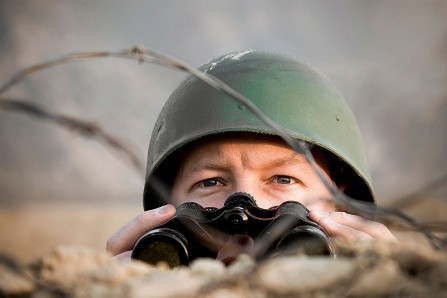A new study examines the mystery of why veterans can lose their vision long after combat, and what can be done about the problem.
Veterans aren’t surprised when they suffer hearing loss after combat exposure to explosions, but they may be surprised to know that their vision may also suffer.
To address the problem, University at Buffalo researchers who work at the Veterans Affairs Western New York Healthcare System (Buffalo VA), have received a grant from the U.S. Department of Veterans Affairs to study how that vision loss occurs and how it might be prevented.
The three-year, $500,000 award was made to Steven J. Fliesler, PhD, Meyer H. Riwchun Endowed Chair Professor of Ophthalmology in the University at Buffalo School of Medicine and Biomedical Sciences. He also is research health scientist at the Buffalo VA and director of its vision research center. Co-investigator on the grant is Machelle T. Pardue, PhD, of Emory University and the Atlanta VA Medical Center.
The grant is one of 150 clinical and basic science studies being performed at the Buffalo VA by UB physicians and physician-scientists. A total of 115 UB medical school faculty have joint appointments at the Buffalo VA.
Joint UB-VA research has a robust history in Buffalo, according to James Lohr, MD, professor in the UB Department of Medicine and acting associate chief of staff, research and development in the Buffalo VA. One of the oldest and best known collaborative research projects resulted in the development in the 1950s of the implantable cardiac pacemaker by physicians at the Buffalo VA and inventor Wilson Greatbatch, then an assistant professor of engineering at UB.
Collaborative UB-VA research totals $4.5 million in annual funding, Lohr says. These studies range from laboratory research to clinical trials that involve human subjects to population studies made possible by the VA’s extensive electronic medical records database.
“A major emphasis of both UB and the VA is clinical and translational research,” says Lohr. “That means taking findings from bench research and making them applicable to the clinical setting to develop new or improved treatments for patients. Only with the collaboration of researchers at UB and the Buffalo VA will we be able to improve the health care of veterans and the community at large.”
The new study on vision loss in blast victims highlights this translational emphasis. Fliesler, the principal investigator, is co-director of the translational pilot studies program of the Buffalo Translational Consortium, headquartered at UB’s Clinical and Translational Research Center.
He explains that veterans in combat zones who are exposed to blast overpressure, such as shock waves from improvised explosive devices (IEDs), often experience injury to multiple tissues and organs, including the brain, a condition known as polytrauma.
“Most reports about eye injuries from blast focus on immediate and overt trauma to the eye that requires surgical intervention,” he says. “Little is known, however, about how injuries that are not overtly apparent affect the retina per se especially because these injuries may take many weeks or months to manifest.”
The research Fliesler and his colleague are beginning will identify exactly how such injuries are caused. The grant will focus initially on the basic biological mechanisms involved in these injuries and will progress toward the development and testing of compounds that could prevent or minimize such injuries before soldiers are exposed to blasts.
“The idea is to first identify the molecular signatures in the retina that occur following blast overpressure exposure, which signifies that damage is occurring,” explains Fliesler. “It’s analogous to how miners used canaries to detect toxic gases in mine shafts as an advanced warning of danger.”
In particular, the researchers will be looking for an increase in the biomarkers that are known to occur with retinal damage and neuronal degeneration. They will study the increase in free radicals and iron that are known to occur with many types of retinal degeneration and in traumatic brain injury.
“Our hypothesis is that the damage to the retina after exposure to blast overpressure is preceded by a rise in free radicals and specific biomarkers associated with oxidative stress,” he explained. “We are hopeful that by administering powerful anti-oxidants to soldiers before they go into combat, we might be able to prevent or minimize the retinal damage that results from blast exposure.
“With thousands of active military personnel potentially being subjected to such injury-provoking conditions daily, this presents a significant, yet under-addressed clinical care issue for active military personnel and veterans.” Fliesler adds that while veterans are the intended beneficiaries of this research, the study may also potentially benefit civilians who experience retinal damage as a result of similar types of exposure in industrial settings.
Other major areas of research on which UB and VA collaborations are focused include chronic obstructive pulmonary disease (COPD), pneumonia and other infectious diseases, chronic kidney disease, coronary artery disease, post-traumatic stress disorders, geriatrics, vitamin D deficiency, vascular surgery and cancer therapy.
As one of the UB medical schools’ affiliated teaching hospitals, the Buffalo VA also serves as an extremely valuable training facility for UB medical students, residents and fellows.


